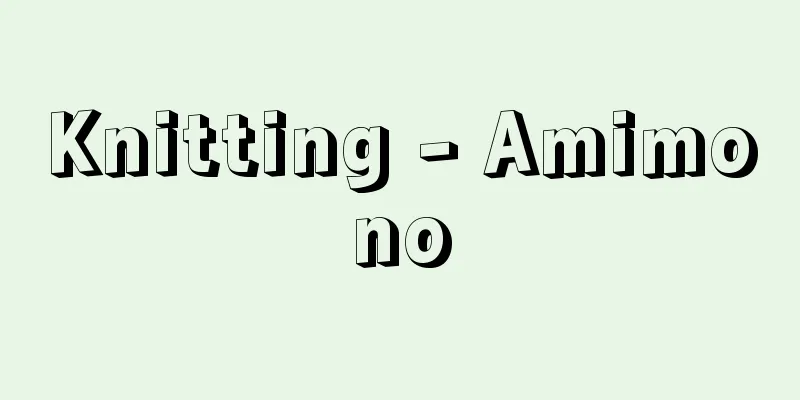Knitting - Amimono

|
It refers to the process of making loops from thread-like material and continuing the loops to create a shape, as well as the resulting product. The meaning of knitting comes from the English word knit, which is derived from the Old English word cynttan, which comes from hand knitting. The word stockinette, which is formed by knitting, is said to be a corruption of the Spanish word medias or the Portuguese word meias. Knit is a general term for knitted fabrics and stockinette products, while stockinette products refer to those knitted by industrial machines. For an anthropological explanation of the act of knitting, please refer to the "knitting" entry. Knitted fabrics are highly elastic and resilient. They have excellent heat retention, and because of the loop structure, they are porous and breathable, and can be re-knitted. By using creative ingenuity in the combination of materials, color schemes, and techniques, a wide range of items can be made, from small handicrafts to underwear, Japanese clothing, general clothing, and interior decorations. [Kawai Kiyomi] kindsKnitting can be broadly divided into hand knitting and machine knitting using domestic knitting machines. Hand knitting includes knitting with needles, crochet knitting, and afghan knitting. Knitting with needles is based on face stitches and purl stitches, and various patterns can be knitted by combining and applying these. Crochet stitches are based on chain stitches, fine stitches, and long stitches. Afghan knitting is based on face stitches and purl stitches. Machine knitting can be used to move stitches and use parts to create a variety of knitting patterns, such as lace patterns, woven patterns, raised stitches, slip stitch patterns, thread knitting with different materials woven in, and others made using double-edged or rubber knitting machines. [Kawai Kiyomi] History in the WestThe origins of knitting are unclear, but it is believed to be quite ancient, and that lace was used as nets for hunting and fishing. Lace discovered among the remains of pyramids dates back to the Egyptian Dynasty (3000 BC-525 BC) and is thought to be the oldest surviving lace. Coptic hats discovered in various parts of Africa and Europe have beautiful patterns that are close to modern knitting. Knitting using two straight needles became established in Italy and France in the 13th century, and between the 14th and 16th centuries, knitting guilds (trade associations) were formed in Florence and Paris, and knitting entered its golden age with the support of religious organizations. The following are some of the characteristics of knitting in European countries at this time: A felted beret in the Basque region of Spain. Beautiful lace socks from France. Italy: Embossed pattern of gold and silver threads. British artistic knitting. Austria, Germany Rope knitting and embroidery. Dutch embossed floral, bird and animal designs. In 1589, the English clergyman William Lee invented a foot-operated stocking knitting machine using a whisker needle. This was the first knitting machine, and marked the first step from the age of hand knitting to the age of machine knitting. After that, knitting machines were improved and developed mainly in England, becoming one of the factors behind the Industrial Revolution. In the 19th century, the Englishman Matthew Townsend invented the Latch Needle, which was more efficient than the whisker needle, and this led to a revolutionary development in the knitting industry. As most knitting machines today use this Latch Needle, it was a significant invention. Hand knitting, which had once been in hiding, began to fade during the Crimean War (1853-1856), when women knitted hats, socks, and gloves for the military, and even ordinary households began to knit shirts, petticoats, and jackets. The First World War increased the demand for knitting, and knitting magazines were published, and people began to make not only underwear but also outerwear. Thus, in the 1930s, knitting made its appearance in the Parisian fashion world and made remarkable progress. [Kawai Kiyomi] Development in JapanWith the arrival of Christianity in the 16th and 17th centuries, the technique of knitting was introduced from Spain, and knitting was manufactured in Nagasaki during the Genroku period (1688-1704). The technique was introduced by foreign missionaries at the end of the Edo period, and it is said that the beginning of machine knitting in Japan was the import of hand-cranked sock knitting machines at the beginning of the Meiji period. During the Rokumeikan period, when European culture was celebrated, lace knitting was introduced, and jackets and shawls became popular among upper class society. During the Sino-Japanese and Russo-Japanese wars, the knitting industry developed rapidly due to the need for large quantities of knitted products as military supplies. In 1923 (Taisho 12), Hagiwara Masa (1883-1974) invented the Garter Knitting Machine. This prompted various studies into hand knitting machines, which have become remarkably popular to this day. Meanwhile, hand knitting is also popular among housewives and young women. Currently, Japanese knitting is showing progress that surpasses the world standard in terms of research into a wide variety of materials and techniques, the development of knitting publications, and fashion sense. In November 1963 (Showa 38), the Japan Knitting Certification Association was established, and knitting skill tests (grades 1-5 for wool, grades 1-3 for lace) are held every September. [Kawai Kiyomi] Traditional designHere are some representative traditional designs from around the world. (1) Guernsey Sweater A fisherman's sweater originating from Guernsey Island (a British territory) at the southwestern end of the English Channel. It is a cylindrical sweater with a simple pattern knitted with thick navy blue yarn, and is a standard of practical design. (2) Jersey Jersey is the name of an island next to Guernsey. In Japan, knitted fabrics for outerwear tend to be called jersey, but the term jersey is said to have originated from a smock-like stockinette sweater made with yarn from this island. (3) Aran Pattern The guernsey sweater trend spread to the Aran Islands, west of Ireland, where it developed into a heavily embossed design. (4) Ropy Sweater A round-yoke sweater knitted with Icelandic roving yarn. Roving yarn is made from the wool of colored sheep called black sheep, which is hand-spun and slightly twisted to create a very thick yarn. Ropy means roving in Icelandic. (5) Fair Isle knitting Fair Isle is an island in the north of Scotland, and is known for its colorful knitting using colorful dyed yarn. The same pattern is never repeated. (6) Nordic Braiding The trend of braiding patterns spread from the Mediterranean to Spain and then to Denmark and Norway. Many of the designs are figurative or geometric, and the shapes are linear, like a smock. (7) Cowichan sweater: Workwear worn by the Cowichan Indians, a hunting tribe living in southwestern Canada. It features bold designs of ptarmigans, deer, and whales. (8) Argyle Check This style originated from the diagonal use of tartan check, a style found in the Argyle region of west Scotland. [Kawai Kiyomi] materialThe yarns used for knitting can be divided into natural and chemical fibers. Know the types and characteristics of these fibers and choose the material according to the purpose. Natural fibers can be divided into animal and plant fibers. Animal fibers include wool (sheep), cashmere (goat), angora (rabbit, goat), camel, alpaca (llama), and silk (silkworm). Wool is the most widely used because it is relatively light, has good heat retention, moisture absorption, and elasticity. Plant fibers include cotton, hemp, choma (ramie), and palm, and are also blended with other fibers. They are less elastic than wool, but have good heat retention, high water absorption, and are strong. Chemical fibers include regenerated fibers, semi-synthetic fibers, synthetic fibers, and inorganic fibers, such as rayon, cupra, acetate, nylon, and tetron. Each has its own characteristics, but all of them are resistant to friction, dry quickly, and are not damaged by insects. Hand-knitted yarn is researched year after year, and a wide variety of yarns in different thicknesses are available on the market. In general, yarn thickness is called extra-fine, medium-fine, medium-thick, etc., and is determined by the thickness and twist. The unit used to express the thickness or thinness of yarn is called the count, which is based on the relationship between the length and weight of the yarn. In the case of wool yarn, 1 gram of wool stretched to a length of 1 meter is count 1, and when stretched to 20 meters it is count 20. Two count 20 yarns twisted together make extra-fine yarn, which is expressed as 2/20 (the denominator is the count, and the numerator is the twist). [Kawai Kiyomi] Yarn twistSingle yarns (single-ply yarns) are made by twisting one thread of each count. Two-ply yarns are made by pulling two single threads together and twisting them in the opposite direction to the single threads. Ultra-fine yarns are made by the number of single threads pulled together into a two-ply yarn; three threads are called "mikko" or three-ply, and four threads are called "yokko" or four-ply. [Kawai Kiyomi] Twist directionThere are S twist (right twist) and Z twist (left twist), and if a single yarn is Z twist, a two-ply yarn is S twist. For hand-knitted yarn, single yarn is Z twist, and two to four yarns are combined to make S twist. [Kawai Kiyomi] Decorative yarnAlso known as fancy yarn, this is a type of yarn made by twisting two or more strands of yarn together, with various changes to the thickness, degree of twist, direction, elasticity, material, shape, and color to give it a distinctive appearance. [Kawai Kiyomi] Stitch symbolAs the number of knitting enthusiasts increased, the number of books and publications also developed significantly. Accordingly, in 1955 (Showa 30), knitting symbols were established and standardized by the JIS (Japan Industrial Standards). Every five years, they are reviewed, confirmed, revised, or abolished. The stitches knitted on a home knitting machine are displayed as knit | purl - over stitch ○ 2 stitches together at top right 2 stitches together at top left, etc., and there are 23 types. There are 22 types of knitted patterns, and 13 types of crocheted patterns (40 symbols), labeled as chain stitches, fine stitches, medium-length stitches, and long stitches. In Afghan stitch, chain stitch, front stitch | back stitch ~ back stitch -- over stitch ○, there are 16 types. [Kawai Kiyomi] maintenanceDry cleaning is recommended. If washing at home, check the type of material and choose a detergent accordingly. If washing wool knitted items at home, follow the steps below. (1) Dissolve neutral detergent in lukewarm water, turn the product upside down, and gently press it to wash it. For heavily soiled areas, apply detergent to the area, place it on the palm of your hand, and tap the dirt off. Change the lukewarm water 2-3 times, and add fabric softener or 5-6 drops of vinegar at the end of the rinse to make the product softer. (2) Wrap it in a towel and squeeze it out, or lightly dehydrate it in a spin dryer to remove the water, reshape it, and dry it in the shade on a board or other surface in a well-ventilated area. If you dry it on a hanger or pole, the weight of the water will cause it to lose its shape. Also, be careful not to expose it to direct sunlight, as this will damage the yarn and cause white yarn to turn yellow. (3) After the garment is thoroughly dried, it is ironed to shape it according to the dimensions of each piece, adjusting the temperature according to the fibers and knitting, and applying steam evenly. For daily care, after wearing, knock off the dust and wipe off dirt from the collar, cuffs, chest, etc. with benzine. Ironing it from time to time before wearing will help prevent it from losing its shape. Children's clothes are prone to wear, so it is more economical to unravel them early and rewind the yarn, or add yarn and re-knit them. Furthermore, domestic knitting machines can knit quickly, making them efficient and convenient when multiple pieces need to be knitted or for professional use. There are also rubber knitting machines (rib knitting machines) and double-plate knitting machines. [Kawai Kiyomi] "All about hand knitting techniques" edited by Tadashi Kikuchi (1981, Silver Knitting Research Group)" ▽ "Lace knitting picture book" edited by Shigeko Kawai (1981, Shufu to Seikatsusha)" ▽ "Knitting Encyclopedia" by Eizaburo Ito (1981, Channeler) [Reference items] | | | | | | | | | | | | |©Shogakukan "> Argyle Check (1) Ball Needles (2) Afghan Needles (3) Five-prong Needles (4) Crochet Hooks (5) Lace Needles (6) Rope Knitting Needles (7) Fray Stoppers (8) Circular Needles (9) Stitch and Row Count Chart (10) Knitting Scale (11) Needle Caps (12) Safety Pins (13) Darning Needles (14) Row Count Rings (15) Stitch Count Rings (16) Raisers (17) Knitting Spools ©Shogakukan "> Knitting tools ©Shogakukan "> Relationship between thread thickness and twist ©Shogakukan "> How to twist the yarn ©Shogakukan "> Classification of hand-knitted yarns by structure Source: Shogakukan Encyclopedia Nipponica About Encyclopedia Nipponica Information | Legend |
|
糸状の素材を用いてループ状にし、そのループを連続しながら一つの形をつくりあげること、およびその製品をいう。編むという意味は、手編からきている古代英語のシンタンcynttanから転じた英語のニットknitをさす。また編成してできたメリヤスという語は、スペイン語のメディアスmedias、あるいは、ポルトガル語のメイアシュmeiasから転訛(てんか)したといわれている。ニットとは編物、メリヤス製品全体の総称であり、メリヤス製品とは、工業用機械で編まれたものをさす。なお、編むという行為の人類学的な解説は「編む」の項を参照されたい。 編物は伸縮性に富み、弾力性がある。保温力に優れ、ループ編成のため多孔性となり通気性があり、編み直しができる。素材の組合せ、配色法や技法など、創意工夫により、手芸的な小物から下着類、和服類、被服全般、室内装飾まで、あらゆる作品ができる。 [河合貴代美] 種類手編と家庭用編機による機械編とに大別でき、手編には、棒針編、かぎ針編、アフガン編がある。棒針編は、表編と裏編が基本となって、これらの組合せ、応用により各種の模様編ができる。かぎ針編は、鎖編、細編(こまあみ)、長編などが基本となる。アフガン編は、表編目、裏編目が基本となる。機械編は、編目の移動、部品の使用などにより、レース模様、編込み模様、引き上げ、すべり目模様や、別素材を織り込んだスレッド編、その他両板機やゴム機によるものなど、さまざまな編地がつくられる。 [河合貴代美] 西洋での歴史編むことの起源は、はっきりしていないが、かなり古く、網として狩猟や漁に用いられたようである。ピラミッドの遺品のなかから発見されたレース編はエジプト王朝(前3000~前525)のもので、現存する最古のものと思われる。アフリカ、ヨーロッパ各地で発見されたコプト人の帽子には、りっぱな模様編があり、現在の編物に近い。2本棒針を使用する編物は、13世紀にイタリア、フランスに定着し、14~16世紀にはフィレンツェやパリに編物ギルド(同業組合)が結成され、宗教団体の後援で編物の黄金時代を迎えた。 このころのヨーロッパ各国の編物の特色として、次のような点があげられる。 スペイン バスク地方ではフェルト化したベレー帽。 フランス 美しいレース編の長靴下。 イタリア 金糸銀糸の浮出し模様。 イギリス 芸術的な編物。 オーストリア、ドイツ 縄編や刺しゅう。 オランダ 花や鳥獣の図案の浮出し編。 1589年、イギリスの牧師ウィリアム・リーが、ひげ針による足踏式靴下編機を発明、これが最初の編機であり、手編の時代から機械編の時代へ第一歩を踏み出すきっかけとなる。その後、編物機械の改良が行われ、イギリスを中心に発達し、産業革命の要因の一つとなった。19世紀には、イギリスのマッシュー・タウンゼントが、ひげ針より高能率のベラ針を考案し、これによって編物工業は画期的発展を遂げることになる。今日のニット編機のほとんどがこのベラ針を用いていることからもわかるように、意義深い発明であった。一時影を潜めていた手編は、クリミア戦争(1853~1856)のおりに軍需用の帽子、靴下、手袋が婦人たちによって編まれ、一般家庭でも、シャツ、ペチコート、ジャケットなどが編まれるようになる。第一次世界大戦により、編物の需要が増大し、編物雑誌なども発行され、下着だけでなく上着までつくるようになる。こうして1930年代には、パリのファッション界にも編物が登場し、目覚ましい発達を遂げた。 [河合貴代美] 日本での発達16~17世紀キリスト教の伝来とともに、スペインからメリヤス編の手法が渡来し、元禄(げんろく)年間(1688~1704)に長崎でメリヤス製造が行われた。江戸末期には外国人宣教師から技術が伝えられ、明治の初期に、手回し式靴下編機を輸入したのが、日本の機械編の初めといわれている。欧風文化を謳歌(おうか)した鹿鳴館(ろくめいかん)時代に、レース編が入ってきたため、上流社会にジャケットや肩掛けが流行した。 日清(にっしん)・日露戦争では、軍需品として多量のメリヤス製品を必要としたことから、メリヤス産業が急速な発達を遂げた。1923年(大正12)、萩原(はぎわら)まさ(1883―1974)がガータ編器を発明。これをきっかけに、手編機はさまざまな研究が加えられ、現在までに目覚ましい普及をみせた。一方、手編も、主婦や若い女性の間で愛好されている。現在日本の編物は、多種多様の素材、技術の研究、編物出版物の発展、ファッション感覚など、世界の水準を抜く進展ぶりをみせている。1963年(昭和38)11月、財団法人日本編物検定協会が結成され、編物技能検定(毛糸は1~5級、レースは1~3級)が毎年9月に行われている。 [河合貴代美] 伝統的デザインここで世界各地に伝わる伝統的デザインの代表をあげてみる。 (1)ガンジー・セーター イギリス海峡の南西端にあるガンジー島(イギリス領)から生まれたフィッシャーマン・セーター。鉄紺の太めの糸で編まれた単純な模様の筒形セーターで、実利的なデザインの標準。 (2)ジャージー ジャージーは、ガンジー島の隣の島の名。日本では、外衣用編地をジャージーとよぶ傾向にあるが、ジャージーという用語の起源は、この島の糸で編まれたスモック風のメリヤス編セーターであるといわれている。 (3)アラン模様 ガンジー・セーターの流れは、アイルランドの西方にあるアラン諸島に伝わり、重々しく浮彫りされたデザインに発展した。 (4)ロピー・セーター アイスランドのロービングヤーンで編まれた、丸ヨークのセーター。ブラック・シープとよばれる色のついた羊の毛を、手つむぎでわずかに撚(よ)りをかけた極太毛糸がロービングヤーン。ロピーとは、アイスランド語でロービングのこと。 (5)フェアー島の編込み フェアー島はスコットランドの北の島で、はでな毛染め糸を使った多色配色の総編込みが特徴。同じ模様を繰り返さないという。 (6)ノルディックの編込み 編込み模様の流れは、地中海からスペインを通り、デンマークやノルウェーに伝わった。具象的な図案や幾何学模様が多く、形はスモック風の直線形。 (7)カウチン・セーター カナダの南西部に住む狩猟民族カウチン・インディアンの労働着。雷鳥や鹿(しか)、鯨など、大胆な図案が特色。 (8)アーガイルチェック スコットランドの西、アーガイル地方に伝わるタータンチェックを斜めに使ったのが始まり。 [河合貴代美] 素材編物の素材となる糸は、天然繊維と化学繊維に分けられる。これらの種類や特性を知り、用途に応じて素材を選択する。天然繊維は動物繊維と植物繊維に分けられ、動物繊維には羊毛(ヒツジ)、カシミヤ(ヤギ)、アンゴラ(ウサギ、ヤギ)、キャメル(ラクダ)、アルパカ(ラマ)、絹(カイコ)などがある。羊毛は、比較的軽く保温性、吸湿性に優れ弾力があるので、もっとも多く使われている。植物繊維は木綿、麻、チョマ(ラミー)、ヤシ(椰子)などがあり、他の繊維との混紡もある。伸縮性は羊毛より劣るが、保温性が高く、吸水性も大で、じょうぶである。化学繊維には再生繊維、半合成繊維、合成繊維、無機質繊維があり、レーヨン、キュプラ、アセテート、ナイロン、テトロンなどである。それぞれに特性があるが、いずれも摩擦に強く、速乾性に優れ、虫害を受けない。 手編糸は年々研究され、種類や太さも多種多様の糸が市販されている。一般に毛糸の太さは極細、中細、並太などとよび、太さと撚りによって決められている。糸の太さ、細さを表す単位を番手といい、糸の長さと重さの関係を基準としたものである。毛糸の場合、1グラムの羊毛を1メートルの長さに引き伸ばしたものが1番手、20メートルに引き伸ばしたものは20番手である。20番手の糸を2本撚り合わせたものが極細で、2/20と表す(分母は番手、分子は撚り)。 [河合貴代美] 糸の撚り単糸(たんし)(片撚り糸)は、それぞれの番手の糸1本に下撚りをかけたもの。双糸(そうし)は、単糸を2本引きそろえ、単糸と反対の方向に撚ったもの。極細は、双糸で引きそろえる単糸の本数で、3本なら「みっこ」、またはスリープライ、4本なら「よっこ」、またはフォープライといわれる。 [河合貴代美] 撚りの方向S撚り(右撚り)とZ撚り(左撚り)とに分けられ、単糸がZ撚りならば、双糸はS撚りになる。手編毛糸は、単糸はZ撚りで、2本から4本あわせてS撚りにする。 [河合貴代美] 意匠撚糸飾り糸(ファンシーヤーン)ともいい、2本以上の糸を撚り合わせるとき、糸の太さ、撚りの程度、方向、弾力、材質、形態、色など、いろいろ変化させて特徴のある外観をもたせた糸。 [河合貴代美] 編目記号編物愛好家が増加するとともに、図書出版物も著しく発展した。それに伴って1955年(昭和30)に編物の表示記号がJIS(ジス)(日本工業規格)によって制定、統一された。5年経過ごとに審議され確認、改正、廃止される。 家庭用編機編目は表目| 裏目― かけ目○ 右上2目一度 左上2目一度などと表示し、23種ある。 棒針編のものは22種、かぎ針編は、鎖編目 細編目× 中長編目 長編目と表示し、13種(記号数40)である。 アフガン編では、鎖編目 表編目| もどり編目~ 裏編目― かけ目○と表し、16種ある。 [河合貴代美] 手入れドライクリーニングするのがよい。家庭で洗濯する場合は、素材の種類を確かめて洗剤を選ぶ。ウールの編物を家庭で洗う場合は以下のようにする。 (1)ぬるま湯に中性洗剤を溶かし、製品を裏返して浸し、軽く押し洗いをする。汚れのひどいところは、その部分に洗剤をつけ、手のひらにのせて汚れをたたき落とす。ぬるま湯を2~3回取り替えて、すすぎの最後に柔軟仕上げ剤を加えるか、酢を5~6滴落とすとふっくらする。 (2)タオルで包んで押し絞りをするか、脱水機で軽く脱水して水気をとり、形を整え、風通しのよいところで、板などの上に置いて陰干しにする。ハンガーや竿(さお)に干すと、水の重みで形くずれする。また、直射日光に当てると毛糸が傷み、白毛糸は黄変するので注意が必要。 (3)アイロンは、よく乾いてから各部分の寸法にあわせて形を整え、繊維や編地によって温度を調節し、蒸気をむらなく当てる。 日常の手入れは、着用後、ほこりをたたき、襟、袖口(そでぐち)、胸元などの汚れはベンジンでふき取る。ときどきアイロンを当てて着ると、形くずれを防ぐことができる。子供物は、傷みが激しいので、早めにほどいて糸を繰り回すか、糸を足して編み直したほうが経済的である。 なお家庭用編機は、速度が早く編めるので、何枚も編む必要のあるときや、職業用として効率よく便利である。ゴム機(リブ機)、両板機もある。 [河合貴代美] 『菊地正監修『手あみ技法のすべて』(1981・シルバー編物研究会)』▽『河合茂子監修『レース編み絵本』(1981・主婦と生活社)』▽『伊藤英三郎著『ニット総合事典』(1981・チャネラー)』 [参照項目] | | | | | | | | | | | | |©Shogakukan"> アーガイルチェック (1)玉つき棒針 (2)アフガン針 (3)5本棒針 (4)かぎ針 (5)レース針 (6)なわ編針 (7)ほつれ止め (8)輪針 (9)目数・段数早見表 (10)編物用縮尺 (11)棒針キャップ (12)まち針 (13)とじ針 (14)段数リング (15)目数リング (16)起毛器 (17)編み込み用糸巻©Shogakukan"> 編物の用具 ©Shogakukan"> 糸の太さと撚りの関係 ©Shogakukan"> 糸の撚り方 ©Shogakukan"> 手編糸の組織形態による分類 出典 小学館 日本大百科全書(ニッポニカ)日本大百科全書(ニッポニカ)について 情報 | 凡例 |
<<: Net pattern lantern Chrysanthemum paulownia - Amimomoyotouronokikkiri
Recommend
Deep sea fishing - Enyogyogyō
A general term for fishing that is conducted far ...
Arisige Oyamada
?-? A samurai from the late Heian to Kamakura per...
South Orkney Islands
A British archipelago in the South Atlantic Ocean,...
Baekje Clan - Kudarauji
A clan of immigrants from Baekje in ancient Japan....
NP-Hard - Npikonn
…If we consider the state of the network correspo...
Nor
Please see the page on "Negative OR". S...
Ninomai - Ninomai
The title of a Gagaku/Bugaku piece. It is in the I...
Papanin - Papanin (English notation) / Ivan Dmitrievich Papanin
Soviet Arctic explorer, scientist, and admiral. H...
Enokizu (Nagasaki)
...The central part of the island is dominated by...
Stevia
Stevia, which has recently become more common in t...
Emotional illusion
…(7)These physiological illusions occur even in a...
Tantia Bhil (English spelling)
In British India, the term was defined as a group...
Hiratsuka Unichi - Hiratsuka Unichi
Printmaker. Born in Matsue, Shimane Prefecture. I...
Beck, HG (English spelling) BeckHG
…Byzantine scholars have often pointed out that t...
Stresemann - Gustav Stresemann
German politician. Before World War I, he disting...






![Ogawa [town] - Ogawa](/upload/images/67cb1a593ec09.webp)

![Kuratake [town] - Kuratake](/upload/images/67cb6d90c5389.webp)
